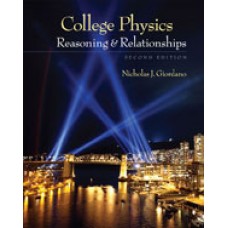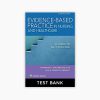Test Bank for College Physics Reasoning and Relationships, 2nd Edition
$35.00 Original price was: $35.00.$26.50Current price is: $26.50.
Test Bank for College Physics Reasoning and Relationships, 2nd Edition
Test Bank for College Physics Reasoning and Relationships, 2nd Edition

Product details:
- ISBN-10 : 0840058195
- ISBN-13 : 978-0840058195
- Author: Nicholas J. Giordano
Master the fundamental concepts of physics with COLLEGE PHYSICS: REASONING AND RELATIONSHIPS. The theme of Reasoning and Relationships is reinforced throughout the book, helping you master these concepts, apply them to solve a variety of problems, and appreciate the relevance of physics to your career and your everyday life. By understanding the reasoning behind problem solving, you learn to recognize the concepts involved, think critically about them, and move beyond merely memorizing facts and equations.
Table contents:
- Chapter 1: Introduction
- 1.1 The Purpose of Physics
- 1.2 Problem Solving in Physics: Reasoning and Relationships
- 1.3 Dealing with Numbers
- 1.4 Physical Quantities and Units of Measure
- 1.5 Dimensions and Units
- 1.6 Algebra and Simultaneous Equations
- 1.7 Trigonometry
- 1.8 Vectors
- Chapter 2: Motion, Forces, and Newton’s Laws
- 2.1 Aristotle’s Mechanics
- 2.2 What Is Motion?
- 2.3 The Principle of Inertia
- 2.4 Newton’s Laws of Motion
- 2.5 Why Did It Take Newton to Discover Newton’s Laws?
- 2.6 Thinking about the Laws of Nature
- Chapter 3: Forces and Motion in One Dimension
- 3.1 Motion of a Spacecraft in Interstellar Space
- 3.2 Normal Forces and Weight
- 3.3 Adding Friction to the Mix
- 3.4 Free Fall
- 3.5 Cables, Strings, and Pulleys: Transmitting Forces from Here to There
- 3.6 Reasoning and Relationships: Finding the Missing Piece
- 3.7 Parachutes, Air Drag, and Terminal Speed
- 3.8 Life as a Bacterium
- Chapter 4: Forces and Motion in Two and Three Dimensions
- 4.1 Statics
- 4.2 Projectile Motion
- 4.3 A First Look at Reference Frames and Relative Velocity
- 4.4 Further Applications of Newton’s Laws
- 4.5 Detecting Acceleration: Reference Frames and the Workings of the Ear
- 4.6 Projectile Motion Revisited: The Effect of Air Drag
- Chapter 5: Circular Motion and Gravitation
- 5.1 Uniform Circular Motion
- 5.2 Examples of Circular Motion
- 5.3 Newton’s Law of Gravitation
- 5.4 Planetary Motion and Kepler’s Laws
- 5.5 Moons and Tides
- 5.6 Deep Notions Contained in Newton’s Law of Gravitation
- Chapter 6: Work and Energy
- 6.1 Force, Displacement, and Work
- 6.2 Kinetic Energy and the Work–Energy Theorem
- 6.3 Potential Energy and Conservation of Energy
- 6.4 More Potential Energy Functions
- 6.5 Conservative versus Nonconservative Forces and Conservation of Energy
- 6.6 The Nature of Nonconservative Forces: What Is Friction Anyway?
- 6.7 Power
- 6.8 Work, Energy, and Molecular Motors
- Chapter 7: Momentum, Impulse, and Collisions
- 7.1 Momentum
- 7.2 Force and Impulse
- 7.3 Conservation of Momentum
- 7.4 Collisions
- 7.5 Using Momentum Conservation to Analyze Inelastic Events
- 7.6 Center of Mass
- 7.7 A Bouncing Ball and Momentum Conservation
- 7.8 The Importance of Conservation Principles in Physics
- Chapter 8: Rotational Motion
- 8.1 Describing Rotational Motion
- 8.2 Torque and Newton’s Laws for Rotational Motion
- 8.3 Rotational Equilibrium
- 8.4 Moment of Inertia
- 8.5 Rotational Dynamics
- 8.6 Combined Rotational and Translational Motion
- Chapter 9: Energy and Momentum of Rotational Motion
- 9.1 Kinetic Energy of Rotation
- 9.2 Conservation of Energy and Rotational Motion
- 9.3 Angular Momentum
- 9.4 Angular Momentum and Kepler’s Second Law of Planetary Motion
- 9.5 The Vector Nature of Rotational Motion: Gyroscopes
- 9.6 Cats and Other Rotating Objects
- Chapter 10: Fluids
- 10.1 Pressure and Density
- 10.2 Fluids and the Effect of Gravity
- 10.3 Hydraulics and Pascal’s Principle
- 10.4 Buoyancy and Archimedes’s Principle
- 10.5 Fluids in Motion: Continuity and Bernoulli’s Equation
- 10.6 Real Fluids: A Molecular View
- 10.7 Turbulence
- Chapter 11: Harmonic Motion and Elasticity
- 11.1 General Features of Harmonic Motion
- 11.2 Examples of Simple Harmonic Motion
- 11.3 Harmonic Motion and Energy
- 11.4 Stress, Strain, and Hooke’s Law
- 11.5 Damping and Resonance
- 11.6 Detecting Small Forces
- Chapter 12: Waves
- 12.1 What Is a Wave?
- 12.2 Describing Waves
- 12.3 Examples of Waves
- 12.4 The Geometry of a Wave: Wave Fronts
- 12.5 Superposition and Interference
- 12.6 Reflection
- 12.7 Refraction
- 12.8 Standing Waves
- 12.9 Seismic Waves and the Structure of the Earth
- Chapter 13: Sound
- 13.1 Sound Is a Longitudinal Wave
- 13.2 Amplitude and Intensity of a Sound Wave
- 13.3 Standing Sound Waves
- 13.4 Beats
- 13.5 Reflection and Scattering of Sound
- 13.6 The Doppler Effect
- 13.7 Applications
- Chapter 14: Temperature and Heat
- 14.1 Thermodynamics: Applying Physics to a “System”
- 14.2 Temperature and Heat
- 14.3 Thermal Equilibrium and the Zeroth Law of Thermodynamics
- 14.4 Phases of Matter and Phase Changes
- 14.5 Thermal Expansion
- 14.6 Heat Conduction
- 14.7 Convection
- 14.8 Heat and Radiation
- Chapter 15: Gases and Kinetic Theory
- 15.1 Molecular Picture of a Gas
- 15.2 Ideal Gases: An Experimental Perspective
- 15.3 Ideal Gases and Newton’s Laws
- 15.4 Kinetic Theory
- 15.5 Diffusion
- 15.6 Deep Puzzles in Kinetic Theory
- Chapter 16: Thermodynamics
- 16.1 Thermodynamics Is About the Way a System Exchanges Energy with Its Environment
- 16.2 The Zeroth Law of Thermodynamics and the Meaning of Temperature
- 16.3 The First Law of Thermodynamics and the Conservation of Energy
- 16.4 Thermodynamic Processes
- 16.5 The Second Law of Thermodynamics
- 16.6 Heat Engines and Other Thermodynamic Devices
- 16.7 Entropy
- 16.8 The Third Law of Thermodynamics and Absolute Zero
- 16.9 Thermodynamics and Photosynthesis
- 16.10 Converting Heat Energy to Mechanical Energy and the Origin of the Second Law of Thermodynamics
- Chapter 17: Electric Forces and Fields
- 17.1 Evidence for Electric Forces: The Observational Facts
- 17.2 Electric Forces and Coulomb’s Law
- 17.3 The Electric Field
- 17.4 Conductors, Insulators, and the Motion of Electric Charge
- 17.5 Electric Flux and Gauss’s Law
- 17.6 Applications: DNA Fingerprinting
- 17.7 “Why Is Charge Quantized?” and Other Deep Questions
- Chapter 18: Electric Potential
- 18.1 Electric Potential Energy
- 18.2 Electric Potential: Voltage
- 18.3 Equipotential Lines and Surfaces
- 18.4 Capacitors
- 18.5 Dielectrics
- 18.6 Electricity in the Atmosphere
- 18.7 Biological Examples and Applications
- 18.8 Electric Potential Energy Revisited: Where Is the Energy?
- Chapter 19: Electric Currents and Circuits
- 19.1 Electric Current: The Flow of Charge
- 19.2 Batteries
- 19.3 Current and Voltage in a Resistor Circuit
- 19.4 DC Circuits: Batteries, Resistors, and Kirchhoff’s Rules
- 19.5 DC Circuits: Adding Capacitors
- 19.6 Making Electrical Measurements: Ammeters and Voltmeters
- 19.7 RC Circuits as Filters
- 19.8 Electric Currents in the Human Body
- 19.9 Household Circuits
- 19.10 Temperature Dependence of Resistance and Superconductivity
- Chapter 20: Magnetic Fields and Forces
- 20.1 Sources of Magnetic Fields
- 20.2 Magnetic Forces Involving Bar Magnets
- 20.3 Magnetic Force on a Moving Charge
- 20.4 Magnetic Force on an Electric Current
- 20.5 Torque on a Current Loop and Magnetic Moments
- 20.6 Motion of Charged Particles in the Presence of Electric and Magnetic Fields
- 20.7 Calculating the Magnetic Field: Ampère’s Law
- 20.8 Magnetic Materials: What Goes On Inside?
- 20.9 The Earth’s Magnetic Field
- 20.10 Applications of Magnetism
- 20.11 The Puzzle of a Velocity-Dependent Force
- Chapter 21: Magnetic Induction
- 21.1 Why Is It Called Electromagnetism?
- 21.2 Magnetic Flux and Faraday’s Law
- 21.3 Lenz’s Law and Work–Energy Principles
- 21.4 Inductance
- 21.5 RL Circuits
- 21.6 Energy Stored in a Magnetic Field
- 21.7 Applications
- 21.8 The Puzzle of Induction from a Distance
- Chapter 22: Alternating-Current Circuits and Machines
- 22.1 Generation of AC Voltages
- 22.2 Analysis of AC Resistor Circuits
- 22.3 AC Circuits with Capacitors
- 22.4 AC Circuits with Inductors
- 22.5 LC Circuits
- 22.6 Resonance
- 22.7 AC Circuits and Impedance
- 22.8 Frequency-Dependent Behavior of AC Circuits: A Conceptual Recap
- 22.9 Transformers
- 22.10 Motors
- 22.11 What Can AC Circuits Do That DC Circuits Cannot?
- Chapter 23: Electromagnetic Waves
- 23.1 The Discovery of Electromagnetic Waves
- 23.2 Properties of Electromagnetic Waves
- 23.3 Electromagnetic Waves Carry Energy and Momentum
- 23.4 Types of Electromagnetic Radiation: The Electromagnetic Spectrum
- 23.5 Generation and Propagation of Electromagnetic Waves
- 23.6 Polarization
- 23.7 Doppler Effect
- 23.8 Deep Concepts and Puzzles Connected with Electromagnetic Waves
- Chapter 24: Geometrical Optics
- 24.1 Ray (Geometrical) Optics
- 24.2 Reflection from a Plane Mirror: The Law of Reflection
- 24.3 Refraction
- 24.4 Reflections and Images Produced by Curved Mirrors
- 24.5 Lenses
- 24.6 How the Eye Works
- 24.7 Optics in the Atmosphere
- 24.8 Aberrations
- Chapter 25: Wave Optics
- 25.1 Coherence and Conditions for Interference
- 25.2 The Michelson Interferometer
- 25.3 Thin-Film Interference
- 25.4 Light through a Single Slit: Qualitative Behavior
- 25.5 Double-Slit Interference: Young’s Experiment
- 25.6 Single-Slit Diffraction: Interference of Light from a Single Slit
- 25.7 Diffraction Gratings
- 25.8 Optical Resolution and the Rayleigh Criterion
- 25.9 Why Is the Sky Blue?
- 25.10 The Nature of Light: Wave or Particle?
- Chapter 26: Applications of Optics
- 26.1 Applications of a Single Lens: Contact Lenses, Eyeglasses, and the Magnifying Glass
- 26.2 Microscopes
- 26.3 Telescopes
- 26.4 Cameras
- 26.5 CDs and DVDs
- 26.6 Optical Fibers
- 26.7 Microscopy with Optical Fibers
- Chapter 27: Relativity
- 27.1 Newton’s Mechanics and Relativity
- 27.2 The Postulates of Special Relativity
- 27.3 Time Dilation
- 27.4 Simultaneity Is Not Absolute
- 27.5 Length Contraction
- 27.6 Addition of Velocities
- 27.7 Relativistic Momentum
- 27.8 What Is “Mass”?
- 27.9 Mass and Energy
- 27.10 The Equivalence Principle and General Relativity
- 27.11 Relativity and Electromagnetism
- 27.12 Why Relativity Is Important
- Chapter 28: Quantum Theory
- 28.1 Particles, Waves, and “Particle-Waves”
- 28.2 Photons
- 28.3 Wavelike Properties of Classical Particles
- 28.4 Electron Spin
- 28.5 The Meaning of the Wave Function
- 28.6 Tunneling
- 28.7 Detection of Photons by the Eye
- 28.8 The Nature of Quanta: A Few Puzzles
- Chapter 29: Atomic Theory
- 29.1 Structure of the Atom: What’s Inside?
- 29.2 Atomic Spectra
- 29.3 Bohr’s Model of the Atom
- 29.4 Wave Mechanics and the Hydrogen Atom
- 29.5 Multielectron Atoms
- 29.6 Chemical Properties of the Elements and the Periodic Table
- 29.7 Applications
- 29.8 Quantum Mechanics and Newton’s Mechanics: Some Philosophical Issues
- Chapter 30: Nuclear Physics
- 30.1 Structure of the Nucleus: What’s Inside?
- 30.2 Nuclear Reactions: Spontaneous Decay of a Nucleus
- 30.3 Stability of the Nucleus: Fission and Fusion
- 30.4 Biological Effects of Radioactivity
- 30.5 Applications of Nuclear Physics in Medicine and Other Fields
- 30.6 Questions about the Nucleus
- Chapter 31: Physics in the 21st Century
- 31.1 Cosmic Rays
- 31.2 Matter and Antimatter
- 31.3 Quantum Electrodynamics
- 31.4 Elementary Particle Physics: The Standard Model
- 31.5 The Fundamental Forces of Nature
- 31.6 Elementary Particle Physics: Is This the Final Answer?
- 31.7 Astrophysics and the Universe
- 31.8 Physics and Interdisciplinary Science
- Appendix A: Reference Tables
- Appendix B: Mathematical Review
- B.1 Mathematical Symbols
- B.2 Algebra and Working with Equations
- B.3 Scientific Notation
- B.4 Geometry and Trigonometry
- B.5 Vectors
- B.6 Exponential Functions and Logarithms
- B.7 Some Relations Useful in Special Relativity
- Answers to Concept Checks and Odd-Numbered Problems
- Index
People also search:
college physics reasoning and relationships
physics reasoning
is physics 2 related to physics 1
college physics 2 review
7 college physics syllabus











